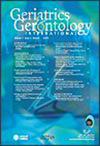Anticholinergic burden quantified using the Japanese risk scale as a predictor of frailty and sarcopenia among community-dwelling older adults: A 9-year Kashiwa cohort study
Abstract
Aim
Given the adverse effects of anticholinergic drugs and the necessity for medication evaluation tools in the aging population, a comprehensive scale to assess the total anticholinergic burden in Japan was developed. We examined the longitudinal association between the anticholinergic burden, quantified using the Japanese Anticholinergic Drug Risk Scale, and the development of frailty and sarcopenia in older adults.
Methods
In this longitudinal population-based cohort study, 2044 older residents without long-term care needs were randomly selected from a community in Kashiwa, Japan. Baseline data were collected in 2012, with follow-ups in 2013, 2014, 2016, 2018, and 2021. Medications were identified through interviews and assessed with the Screening Tool for Older Persons' Appropriate Prescriptions for the Japanese. The anticholinergic burden was quantified using the Japanese Anticholinergic Risk Scale. We evaluated new-onset frailty and sarcopenia using the Cardiovascular Health Study Index and Asian Working Group for Sarcopenia 2019 criteria, respectively.
Results
Of the 1549 participants without sarcopenia or frailty at baseline (age 72.5 ± 5.5 years; 49.1% women; median follow-up 6.0 years), 274 and 230 developed new-onset frailty and sarcopenia, respectively, during follow-up. After adjusting for potential confounders, an anticholinergic burden score ≥3 was strongly associated with new-onset frailty and sarcopenia (adjusted hazard ratio [95% confidence interval]: 2.45 [1.52–3.94] and 2.01 [1.20–3.35], respectively).
Conclusions
Anticholinergic burden is a predictor of frailty and sarcopenia in community-dwelling older adults. Effective evaluation and management of anticholinergic burden using the Japanese Anticholinergic Drug Risk Scale are crucial for promoting healthy aging and mitigating adverse health outcomes. Geriatr Gerontol Int 2025; 25: 520–527.


 求助内容:
求助内容: 应助结果提醒方式:
应助结果提醒方式:


